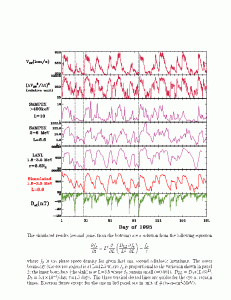Relativistic Electrons and Solar Wind
The finding of Paulikas and Blake in 1979 that the correlation between the solar wind speed and the >1 MeV electron flux at geostationary orbit depends strongly on the solar wind speed about a day before has been a puzzle especially since the solar wind velocity varies by only about a factor of two whereas the MeV electron flux varies by over two orders of magnitude. The almost continuous record of solar wind parameters from WIND and magnetospheric measurements from SAMPEX and satellites at geostationary orbit provide us now with the best data set to tackle this problem. During the two year period (1995-1996) that we have analyzed, nearly every peak in the solar wind speed results in an enhancement in the >1 MeV electrons at geostationary orbit. Furthermore, SAMPEX measurements at different L-values show that the enhancement of energetic electrons occur at large L first, indicating that electrons observed at geostationary orbit come from further out. The years 1995-1996 were during the approach to solar minimum when recurrent high speed solar wind streams were the dominant source of solar wind velocity variation on the time scale of half a solar rotation. We have found that these high speed solar wind streams are associated with much larger relative levels of shorter time scale (about 12 minutes) solar wind velocity fluctuations. The fluctuation level of the solar wind speed on these shorter time scales has a much larger range of variation than the solar wind speed itself and increases with the solar wind speed.
We have used such solar wind speed variations as the input to a radial diffusion equation to simulate MeV electron flux variations in the magnetosphere. Our simulation reproduces the observed MeV electron enhancements. The accompanying figure shows the measurements and simulation results for the first half year of 1995. Thus the correlation between the solar wind speed and MeV electrons in the inner magnetosphere can be understood as a result of enhanced source population of energetic electrons in the outer magnetosphere and also enhanced radial diffusion caused by solar wind velocity variations.
Contributed by Xinlin Li, University of Colorado
«Return to the Results page
